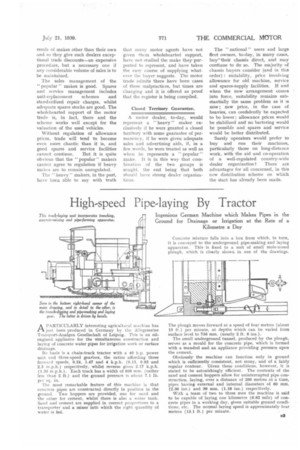High-speed Pipe-laying By Tractor
Page 37

If you've noticed an error in this article please click here to report it so we can fix it.
Ingenious German Machine which Makes Pipes in the Ground for Drainage or Irrigation at the Rate of a Kilometre a Day A PARTICULARLY interesting agricultural machine has just been produced in Germany by the Allegerneine Transport-Analgen Gesellschaft of Leipzig. This is an oilengined appliance for the simultaneous construction and laying of concrete water pipes for irrigation work or surface drainage.
Its basis is a chain-track tractor with a 40 h.p. power Unit and three-speed gearbox, the ratios affording three forward speeds, 0.24, 1.47 and 4 k.p.h. (0.15, 0.93 and 2.5 m.p.h.) respectively, whilst reverse gives 2.17 k.p.h. (1.35 m.p.h.). Each track has a width of 600 mm. (rather less than 2, ft.) and the ground pressure is about 7.1 lb. per sq. in. The most remarkable feature of this machine is that concrete pipes are constructed directly in position in the ground. Two hoppers are provided, one for sand and the other for cement, whilst there is also a water tank. Sand and cement are supplied in correct proportions to a transporter and a mixer 'Mtn which the right quantity of water is fed. Concrete mixture falls into a box from which, in turn, it is conveyed to the underground pipe-making and laying apparatus. This is fixed to a sort of small mole-nosed plough, which is clearly shown in one of the drawings.
The plough moves forward at a speed of four metres (about 13 ft.) per minute, at depths which can be varied from surface level to 750 mm. (nearly 2 ft. 6 ins.).
The small underground tunnel, produced by the plough, serves as a mould for the concrete pipe, which is formed with a mandrel and an appliance providing pressure upon the cement.
Obviously the machine can function only in ground which is sufficiently consistent, not stony, and of a fairly regular contour. Given these conditions, however, it is stated to be astonishingly efficient. The contents of the sand and cement hoppers allow for uninterrupted pipe construction. laying, over a distance of 200 metres at a time, pipes having external and internal diameters of 60 mm. (2.36 ins.) and 30 mm_ (1.18 ins.) respectively.
With a team of two to three men the machine is said to be capable of laying one kilometre (0.62 mile) of concrete pipes in a working day, given suitable ground conditions, etc. The normal laying speed is approximately four metres (13.1 ft.) per minute.












































































